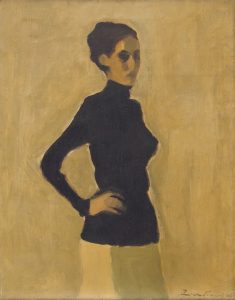 Born in Zagreb but Venetian by choice, Živa Kraus has been an irreplaceable figure on the city’s artistic and cultural scene for over forty years. She defines her life as the consequence of two fundamental choices, the first being to enroll in Painting at the Academy of Fine Arts in her hometown, the second, in 1971, to move to Venice.
Born in Zagreb but Venetian by choice, Živa Kraus has been an irreplaceable figure on the city’s artistic and cultural scene for over forty years. She defines her life as the consequence of two fundamental choices, the first being to enroll in Painting at the Academy of Fine Arts in her hometown, the second, in 1971, to move to Venice.
A multifaceted personality, in her early years in Venice she combined her artistic practice as a painter with other activities that made her become part of the artistic environment, until she actually became an integral part of it. From her acquaintance with Peggy Guggenheim, to whom she acted as assistant in her collection, to her collaboration with Paolo Cardazzo at the Galleria del Cavallino, where she followed the beginnings of video art, and again the curatorship and editing – commissioned by Carlo Ripa di Meana – of the catalogue of the 38th Venice Biennale From nature to art, from art to nature: there are many decisive experiences and encounters that punctuate her career.
However, her main contribution – and tribute – was that of endowing Venice with a space, hitherto lacking, entirely dedicated to photography. With the opening of Ikona Photo Gallery in 1979, Kraus brought photography to the city at a time when this language was still struggling to make its way into the contemporary art circuit in Italy. The chosen name, which derives from the Greek eikon and means image, encapsulates both the imagery of photography as the art of images and the sacred Byzantine icons linked to the history of Venice.
After the gallery’s foundation, initially located on San Moisè Bridge near San Marco and since 2003 based in Campo del Ghetto Nuovo, in 1989 Ikona Venezia International School of Photography was established. Besides her activities carried out at the gallery, from 1982 to 1991 she worked as artistic director of the Galerija Sebastian, with venues in Belgrade, Dubrovnik and Varaždin, and on more than one occasion she coordinated national pavilions and collateral events at various editions of the Biennale. As a painter, Živa Kraus has exhibited in many European cities, including Karlovac, Zagreb, Ljubljana, Brescia, Genoa, Milan, Venice, Auvernier and Bern and is the author of the videotape entitled The Motovun tape made in 1976. In 2019, the Fondazione Ugo and Olga Levi hosted the exhibition ‘Memory for the future: 40 years of Ikona Gallery in Venice’ to celebrate the gallery’s 40th anniversary and to honour Živa Kraus’ eclectic figure as an artist, curator and gallerist.
